Reminiscing

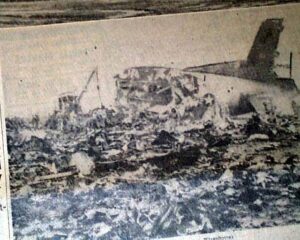 It was December 20, 1952, at the height of the Korean War. Operation Sleigh Ride…a United States Air Force airlift program to bring US servicemen who were fighting in the Korean War home for Christmas. I can imagine the excitement in the air. A chance to “take a break” from the ugliness of war even if only for a short time and spend Christmas at home. At around 6:30pm PST, the C-124 lifted off from Larson
It was December 20, 1952, at the height of the Korean War. Operation Sleigh Ride…a United States Air Force airlift program to bring US servicemen who were fighting in the Korean War home for Christmas. I can imagine the excitement in the air. A chance to “take a break” from the ugliness of war even if only for a short time and spend Christmas at home. At around 6:30pm PST, the C-124 lifted off from Larson 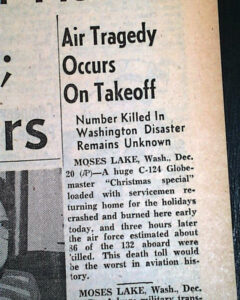 Air Force Base near Moses Lake, Washington. The plane was en route to Kelly Air Force Base, San Antonio, Texas. Then the unthinkable happened. Just seconds after taking, the left wing struck the ground, and the airplane cartwheeled, broke up, exploded, killing 82 of the 105 passengers and 5 of the 10 crew members.
Air Force Base near Moses Lake, Washington. The plane was en route to Kelly Air Force Base, San Antonio, Texas. Then the unthinkable happened. Just seconds after taking, the left wing struck the ground, and the airplane cartwheeled, broke up, exploded, killing 82 of the 105 passengers and 5 of the 10 crew members.
Investigation into the accident revealed that the aircraft’s elevator and rudder gust locks had not been disengaged prior to departure. The reports I have read did not specifically say that the accident was due to pilot error, but I also could not find information stating that is could have been mechanical failure. From that, I have to assume that the crew forgot to disengage the elevator and rudder gust locks, and the plane simply lost control.
 I can’t imagine the devastation of waiting at home for your soldier to come home for Christmas, only to hear that on their way home to you, they were in a crash that took their life. Of course, they wanted their soldier home for Christmas, but my guess is that many carried the weight of that desire for years. If their soldier had stayed in Korea, they might have later come home from the war alive. It was all just too much to bear. This would be the deadliest crash in history, until the Tachikawa air disaster, which also involved a Douglas C-124A-DL Globemaster II and claimed 129 lives. Of course, no crash that involves loss of life, is a minor thing. The devastation the families feel is beyond comprehension.
I can’t imagine the devastation of waiting at home for your soldier to come home for Christmas, only to hear that on their way home to you, they were in a crash that took their life. Of course, they wanted their soldier home for Christmas, but my guess is that many carried the weight of that desire for years. If their soldier had stayed in Korea, they might have later come home from the war alive. It was all just too much to bear. This would be the deadliest crash in history, until the Tachikawa air disaster, which also involved a Douglas C-124A-DL Globemaster II and claimed 129 lives. Of course, no crash that involves loss of life, is a minor thing. The devastation the families feel is beyond comprehension.
 My great grandniece, Izabella Harman is a sweet little girl, who is growing up way too fast. This year finds Belle in 3rd grade this year, and that is so shocking to me. She should still be a preschooler, but don’t tell her I said so, because I’m sure she would not be amused. She is little, yes, but that doesn’t make her a young girl. Being a third grader is in the upper half of elementary school. That makes her one of the big kids, not that she would be one of those kids make a big deal out of that.
My great grandniece, Izabella Harman is a sweet little girl, who is growing up way too fast. This year finds Belle in 3rd grade this year, and that is so shocking to me. She should still be a preschooler, but don’t tell her I said so, because I’m sure she would not be amused. She is little, yes, but that doesn’t make her a young girl. Being a third grader is in the upper half of elementary school. That makes her one of the big kids, not that she would be one of those kids make a big deal out of that.
Belle, as she is called, has been getting into art and is a good little painter. Seriously, how could she be anything but good at art. Her grandmother, Chantel Balcerzak is an amazing artist. Belle comes by it naturally. In fact, I would expect that in the future, Belle will continue to show a continuing talent and maybe even, a career in art. It seems to run in her family…from several of her family members, including her cousin, Michelle Miller, and grandma, Collene Spencer. I look forward to Belle’s contributions to the world of art.
Belle and her aunt, Siara Kirk are great friends. Siara says that Belle takes her side over her dad, Jake Harman, 
 and calls Siara her favorite. Siara says, “Belle is the best cousin, big sister, and niece you could ask for.” Belle is quick to take her daddy on too. They and her brother Jaxx love to wrestle with their daddy to see if they can beat him. They beat him sometimes, but I think he goes easy on them. They probably wouldn’t agree.
and calls Siara her favorite. Siara says, “Belle is the best cousin, big sister, and niece you could ask for.” Belle is quick to take her daddy on too. They and her brother Jaxx love to wrestle with their daddy to see if they can beat him. They beat him sometimes, but I think he goes easy on them. They probably wouldn’t agree.
Belle, Jaxx, and their big sister, Alice all have such a great time with their cousin Nathan Kirk. Nathan is eleven months old, and he thinks his cousins are the greatest. The kids love spending time with him, and eventually, I would expect that Belle will make a great little babysitter in the future too. Today is Belle’s 9th birthday. Happy birthday Belle!! Have a great day!! We love you!!

 My nephew, Isaac Spethman, like many kids, couldn’t wait to grow up. The difference between Isaac and other kids is that he simply didn’t wait to grow up. He got his first job when he was just seven years old, when he walked across the street from his house to the Grant Street Grocery Store and asked for a job. Of course, the owner thinking that this cute little kid was playing a game of sorts, told him to bring in his resume and they would talk. Little did he know that while Isaac didn’t know what a resume was, he knew that his English teacher aunt, Liz Masterson did and that she could help. She helped him to make a great resume, listing all the chores he helped his parents with, and…well, he got the job. They couldn’t pay him in money, of course, but they let him take out the trash, sweep the floor, and straighten things. In return he got things like sandwiches, candy, pop, and a knowledge of the inner workings of a grocery store and butcher shop. Isaac has had some kind of job ever since.
My nephew, Isaac Spethman, like many kids, couldn’t wait to grow up. The difference between Isaac and other kids is that he simply didn’t wait to grow up. He got his first job when he was just seven years old, when he walked across the street from his house to the Grant Street Grocery Store and asked for a job. Of course, the owner thinking that this cute little kid was playing a game of sorts, told him to bring in his resume and they would talk. Little did he know that while Isaac didn’t know what a resume was, he knew that his English teacher aunt, Liz Masterson did and that she could help. She helped him to make a great resume, listing all the chores he helped his parents with, and…well, he got the job. They couldn’t pay him in money, of course, but they let him take out the trash, sweep the floor, and straighten things. In return he got things like sandwiches, candy, pop, and a knowledge of the inner workings of a grocery store and butcher shop. Isaac has had some kind of job ever since. 

While Isaac loves working and getting paid, he is also quick to volunteer to help others, especially his little sister, Aleesia. He helps her with homework and showed her how to shoot and load a gun. He likes to go hiking with the family, working with his dad, and hanging out with his brothers. He also took his girlfriend, Aspen to prom, and well, they made a stunning couple. And…Isaac loves fireworks!! I mean he really loves fireworks!! This year, he spent hundreds of dollars on fireworks. I guess that having a job for all this time affords him the ability to buy the things he wants.
And speaking of buying, this past year…at 17 years old, Isaac had saved enough money to buy his first house. 
 We were all stunned when we heard about that. He is just a very responsible guy, and his first house was the next logical step. Since then, he has been working on making it his own. One way he made it his own had nothing to do with the house. Seriously, what house is complete without a pet. So, Isaac got a cute little (for now) German Shepherd puppy that he named Atlas. Isaac has always wanted to be grown up, and I would say he definitely got the job done in style. Today Is Isaac’s 18th birthday. Happy birthday Isaac!! Have a great day!! We love you!!
We were all stunned when we heard about that. He is just a very responsible guy, and his first house was the next logical step. Since then, he has been working on making it his own. One way he made it his own had nothing to do with the house. Seriously, what house is complete without a pet. So, Isaac got a cute little (for now) German Shepherd puppy that he named Atlas. Isaac has always wanted to be grown up, and I would say he definitely got the job done in style. Today Is Isaac’s 18th birthday. Happy birthday Isaac!! Have a great day!! We love you!!
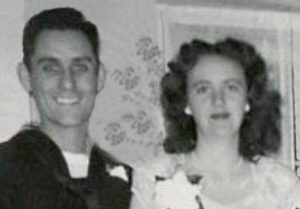
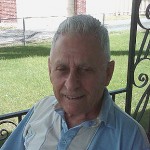 My uncle, George Hushman was the first person I ever knew who was adopted or orphaned. Of course, we didn’t know of his “status” at the time. My sisters, Cheryl Masterson, Caryl Reed, Alena Stevens, and Allyn Hadlock, just knew that we all liked him. Uncle George living in the orphanage in Casper and going to school here when he met my aunt, Evelyn Byer. They fell in love and were married for 68 years, until she went home to be with the Lord. Uncle George lived another three years before joining her.
My uncle, George Hushman was the first person I ever knew who was adopted or orphaned. Of course, we didn’t know of his “status” at the time. My sisters, Cheryl Masterson, Caryl Reed, Alena Stevens, and Allyn Hadlock, just knew that we all liked him. Uncle George living in the orphanage in Casper and going to school here when he met my aunt, Evelyn Byer. They fell in love and were married for 68 years, until she went home to be with the Lord. Uncle George lived another three years before joining her.
Uncle George didn’t know his family for most of his life, but when he joined our family, he became part of a big 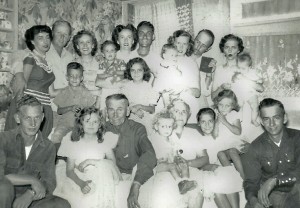 family. Then, with their marriage, the family began to grow. Following their marriage, their five children followed in rapid succession. Their first, a daughter named Sheila Ann, known as Susie to all who know her, was born on November 14, 1948, just fourteen months later. Their first son, George Wave, was born on December 13, 1949, just thirteen months later. He was by Kay on November 8, 1950, Shannon Lee January 27, 1953, and finally Gregory Wane on April 10, 1954. By the time Aunt Evelyn and Uncle George’s family was complete, other children in the Byer family married, the family continued to grow quickly. Of course, The Hushman family didn’t stop there either. Their children have children, grandchildren, and even great grandchildren. Families have a way of doing that.
family. Then, with their marriage, the family began to grow. Following their marriage, their five children followed in rapid succession. Their first, a daughter named Sheila Ann, known as Susie to all who know her, was born on November 14, 1948, just fourteen months later. Their first son, George Wave, was born on December 13, 1949, just thirteen months later. He was by Kay on November 8, 1950, Shannon Lee January 27, 1953, and finally Gregory Wane on April 10, 1954. By the time Aunt Evelyn and Uncle George’s family was complete, other children in the Byer family married, the family continued to grow quickly. Of course, The Hushman family didn’t stop there either. Their children have children, grandchildren, and even great grandchildren. Families have a way of doing that.
I’m sure that if they could see their family now, they would be very proud of not only their numbers, but the 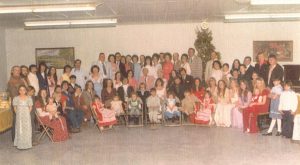
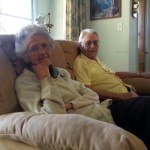 things they have become. Their children and grandchildren have gone on to become responsible adults with amazing careers. And they are still in the process of becoming the great people they are meant to be. Uncle George has been in Heaven now for six years. We all miss him and the rest of the family who have gone on before us. Our goal now is to do what we can to make them all proud. Happy 98th birthday in Heaven, Uncle George. We love and miss you very much.
things they have become. Their children and grandchildren have gone on to become responsible adults with amazing careers. And they are still in the process of becoming the great people they are meant to be. Uncle George has been in Heaven now for six years. We all miss him and the rest of the family who have gone on before us. Our goal now is to do what we can to make them all proud. Happy 98th birthday in Heaven, Uncle George. We love and miss you very much.

 When I asked my sister, Alena Stevens for information on her daughter, Michelle Miller’s year for her birthday story, Alena said, “New house, new job, gut house, rebuild it from the walls up.” I suppose to someone who doesn’t know my sister, or my niece, this would sound sarcastic, but what I saw was a whirlwind, and I think that is quite accurate. For Michelle and her husband, Matt, their lives, this past year, have been just that. In August Michelle and Matt bought their first house at 18th and Nottingham. The house was built in the 1970’s and had not been upgraded since then, except for a bar area downstairs. That made it pretty much a gut job. They moved into the downstairs and decided to tackle the upstairs first.
When I asked my sister, Alena Stevens for information on her daughter, Michelle Miller’s year for her birthday story, Alena said, “New house, new job, gut house, rebuild it from the walls up.” I suppose to someone who doesn’t know my sister, or my niece, this would sound sarcastic, but what I saw was a whirlwind, and I think that is quite accurate. For Michelle and her husband, Matt, their lives, this past year, have been just that. In August Michelle and Matt bought their first house at 18th and Nottingham. The house was built in the 1970’s and had not been upgraded since then, except for a bar area downstairs. That made it pretty much a gut job. They moved into the downstairs and decided to tackle the upstairs first.
Matt and Michelle, with the help of Matt’s parents, they demolished the kitchen, took down a wall, and took up all flooring. Unfortunately, the lady who lived there was a smoker so the house reeked of smoke. She also had a cat so it smelled of that too. They worked tirelessly just to get the smell out for several days. Finally, they put 
 Kilz down on the floor boards and that got rid of it. The wall had outdated wall paper everywhere that had to be taken down. Dawn, Matt’s mom, and Michelle tackled that while Matt and his dad worked on taking out carpet and fixing walls and other things.
Kilz down on the floor boards and that got rid of it. The wall had outdated wall paper everywhere that had to be taken down. Dawn, Matt’s mom, and Michelle tackled that while Matt and his dad worked on taking out carpet and fixing walls and other things.
They were able to add a powder room off the kitchen by taking away a little of the master bath and add a second pantry area, both very nice features. Then they put in new flooring and new cabinets and counter tops. Of course, during this time, they had no kitchen, adding to the difficulties. Cooking was done with an air fryer, microwave, and crockpot, and they were thankful that they had those things. They had no kitchen sink for dishes, so they had to make do worth the bathroom sink. They love being in their own home and making it their own. With a lot of work and dedication it is going to be a great house.
Michelle is an educated art teacher, and she has worked for the Nicolaysen Art Museum since her graduation. Unfortunately, while she loved the Nic and her job there, it is a nonprofit, so there isn’t any room for raises and 
 promotions. So, in October, Michelle started looking for another job. She got an offer from Phoenix Capital Investments, an oil and gas investment company. She has been there since November and she likes her work very much. She got a substantial raise in pay and there is plenty of room for growth. I’m sure Michelle will do quite well in her new job. She is very capable and dedicated. Today is Michelle’s birthday!! Happy birthday Michelle!! Have a great day!! We love you!!
promotions. So, in October, Michelle started looking for another job. She got an offer from Phoenix Capital Investments, an oil and gas investment company. She has been there since November and she likes her work very much. She got a substantial raise in pay and there is plenty of room for growth. I’m sure Michelle will do quite well in her new job. She is very capable and dedicated. Today is Michelle’s birthday!! Happy birthday Michelle!! Have a great day!! We love you!!
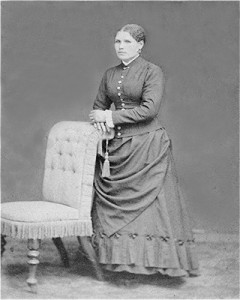
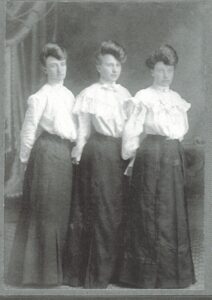
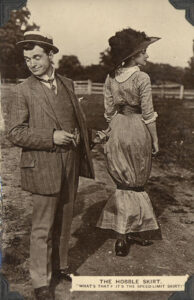 During World War II, as with other wars, things that were needed for the war effort had to be rationed. Things like metal, gasoline, even food made sense to me, but while I was listening to a book called “The Monuments Men” and shorter skirts were mentioned. My first thought was, “How did shorter skirts help the war effort? The men’s morale maybe, but seriously…how?” Well, it turns out that morale had nothing to do with it. The reasons lay elsewhere. Apparently, wool and silk were in high demand to make uniforms and parachutes. For manufacturers, that meant using materials like rayon and viscose (a semi-synthetic type of rayon fabric made from wood pulp that is used as a silk substitute. It has a similar drape and smooth feel to the luxury material) to make most civilians clothing.
During World War II, as with other wars, things that were needed for the war effort had to be rationed. Things like metal, gasoline, even food made sense to me, but while I was listening to a book called “The Monuments Men” and shorter skirts were mentioned. My first thought was, “How did shorter skirts help the war effort? The men’s morale maybe, but seriously…how?” Well, it turns out that morale had nothing to do with it. The reasons lay elsewhere. Apparently, wool and silk were in high demand to make uniforms and parachutes. For manufacturers, that meant using materials like rayon and viscose (a semi-synthetic type of rayon fabric made from wood pulp that is used as a silk substitute. It has a similar drape and smooth feel to the luxury material) to make most civilians clothing.
In addition to the types of material, the manufacturers had to find a way to actually conserve the amount of fabric being used, so to conserve fabric, dressmakers and manufacturers began designing shorter skirts and slimmer silhouettes. In the book, the comment was made that because so many people walked to work, the women had shapely legs, so I guess the men appreciated the new styles, much like when the miniskirt came into style in the 70s. Although, the women of the World War II era didn’t wear miniskirts. The dresses were just about knee length or slightly longer. The use of shoulder pads ended in World War II as well, although it has made periodic comebacks over the years. Another way that the manufacturers found to conserve fabric, was 

 the elimination of the cuff on men’s slacks. Oddly, that change was not as much appreciated by the men in World War II, although these days, cuffs on pants are a rarity, if you see them at all. Mostly these days, you might see pant legs rolled and that mostly on women, but not a real cuff.
the elimination of the cuff on men’s slacks. Oddly, that change was not as much appreciated by the men in World War II, although these days, cuffs on pants are a rarity, if you see them at all. Mostly these days, you might see pant legs rolled and that mostly on women, but not a real cuff.
Dress hemlines have been known to fluctuate with the times. The pre 1900s showed women with long full dresses that even dragged the ground, full slips and absolutely no ankles or feet showing. I suppose anyone showing an ankle or foot would be considered…loose. By the 1900s, the era of my Spencer great aunts, the skirts were still very long, but with a slimmer cut and fewer full slips to carry around. One of the oddest style came in 1910, when the Hobble Skirt came out. Of course, variations would be the pencil skirt. The roaring 20s, brought a carefree attitude and long cumbersome skirts were replaced with short, knee length (and maybe slightly shorter) skirts, suitable for rather wild dancing. With the stock market crash of 1929, the Crashing 30’s began, and skirts were again long and very conservative. There was no need for flashy dancewear, and there was not much dancing going on. Then, came World War II. Our men were fighting and we…the ones back at home had to make some sacrifices, So, came the shorter skirts made of rayon and such to save the normal materials for our “boys, fighting over there.” When the war ended, the ration weary women went back to their fuller, and slightly longer skirt, because…well they could. And then came the 60s…the era of free love and free expression. The miniskirt arrived, much to the horror of our parents. The Beatles were the rage, and the skirts grew (or shrank) to ever 

 shorter lengths. By the late 70s, the midi and maxiskirts had arrived. And so came the Hippie era. Everything was “free flowing and filled with flowers.” To me, it seems that since that time, skirts have been a mix of lengths, from the micromini to the maxi, but in reality, many women gave up skirts completely for jeans, short shorts (hot pants), capris, or whatever else suited our “fancies” because it was all available. I suppose a day could come again, when fashion would change because of war, politics, or personal preference. Styles often repeat. Time will tell that story.
shorter lengths. By the late 70s, the midi and maxiskirts had arrived. And so came the Hippie era. Everything was “free flowing and filled with flowers.” To me, it seems that since that time, skirts have been a mix of lengths, from the micromini to the maxi, but in reality, many women gave up skirts completely for jeans, short shorts (hot pants), capris, or whatever else suited our “fancies” because it was all available. I suppose a day could come again, when fashion would change because of war, politics, or personal preference. Styles often repeat. Time will tell that story.

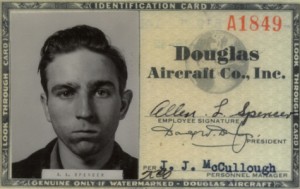 As a young man, my dad, Allen L Spencer worked for Douglas Aircraft Company. Of course, he wasn’t there when the DC-3 took its first flight, mostly because he was only eleven at the time, but I have a feeling that if he happened to see a plane flying overhead, he was probably enamored of them immediately. So, I’m sure that the idea of working to build these machines, much have been quite thrilling for him. I am also quite sure that Dad might have worked on the DC-3, since it was a plane used in World War II. Dad left Douglas Aircraft Company in early 1943, when he was called to serve in World War II. After basic training, he was called to be part of a B-17 Bomber crew. I’m sure they wanted to make use of his experience at Douglas Aircraft Company, because soon, Dad was the flight engineer and top turret gunner on his crew. The flight engineer needs to know everything about the plane, because let’s face it, in a plane, you can’t pull over if something goes wrong.
As a young man, my dad, Allen L Spencer worked for Douglas Aircraft Company. Of course, he wasn’t there when the DC-3 took its first flight, mostly because he was only eleven at the time, but I have a feeling that if he happened to see a plane flying overhead, he was probably enamored of them immediately. So, I’m sure that the idea of working to build these machines, much have been quite thrilling for him. I am also quite sure that Dad might have worked on the DC-3, since it was a plane used in World War II. Dad left Douglas Aircraft Company in early 1943, when he was called to serve in World War II. After basic training, he was called to be part of a B-17 Bomber crew. I’m sure they wanted to make use of his experience at Douglas Aircraft Company, because soon, Dad was the flight engineer and top turret gunner on his crew. The flight engineer needs to know everything about the plane, because let’s face it, in a plane, you can’t pull over if something goes wrong.
The Douglas DC-3 is “a propeller-driven airliner produced by the Douglas Aircraft Company. The DC-3 significantly impacted the airline industry from the 1930s through the 1940s and during World War II. It was developed as a larger, enhanced 14-bed sleeper version of the Douglas DC-2. This low-wing metal monoplane features traditional landing gear and is propelled by two radial piston engines with 1,000–1,200 horsepower. Initially, civil DC-3s were equipped with the Wright R-1820 Cyclone engine, but later models adopted the Pratt and Whitney R-1830 Twin Wasp engine. The DC-3 boasts a cruising speed of 207 miles per hour, can accommodate 21 to 32 passengers or carry 6,000 pounds of cargo, has a range of 1,500 miles, and is capable of operating from short runways.”
The DC-3 was filled with exceptional qualities that earlier versions didn’t have. I think that is common as technology advances. It was fast, had a good range. It was more reliable than the prior versions, and it even provided greater passenger comfort. Clearly, it was not designed just for the war, but to go on into the future too. Prior to World War II, it pioneered many air travel routes. It could cross the continental United States from New York to Los Angeles in 18 hours with only three stops. Of course, these days that seems like nothing, but in those days, it was a big deal. It was one of the first airliners that could profitably carry passengers without relying on mail subsidies. In 1939, at the peak of its dominance in the airliner market, approximately 90% of airline flights worldwide were operated by a DC-3 or its variants.
Sadly, after the war, the airliner market was inundated with surplus transport aircraft, rendering the DC-3 less competitive due to its smaller size and slower speed compared to aircraft built during the war. With all that against it, the DC-3 became obsolete on main routes. Soon, it was replaced by more advanced types such as the Douglas DC-4 and Convair 240. However, the design of the DC-3 proved adaptable and remained useful on less commercially demanding routes.
Civilian DC-3 production ceased in 1943 with a total of 607 aircraft. Military variants, including the C-47 
 Skytrain (known as the Dakota in British RAF service). The Soviet-built and Japanese-built versions increased total production to over 16,000 planes. Many continued to serve in various niche roles. It was estimated that 2,000 DC-3s and military derivatives were still operational in 2013. By 2017, more than 300 were still flying, and as of 2023, approximately 150 are estimated to remain in service. This, it would seem, is a very versatile airplane.
Skytrain (known as the Dakota in British RAF service). The Soviet-built and Japanese-built versions increased total production to over 16,000 planes. Many continued to serve in various niche roles. It was estimated that 2,000 DC-3s and military derivatives were still operational in 2013. By 2017, more than 300 were still flying, and as of 2023, approximately 150 are estimated to remain in service. This, it would seem, is a very versatile airplane.

 On this day, December 16th, in the year 1575, an earthquake occurred near Valdivia Chile. The city of Valdivia and the Chiloé Archipelago were once the two southernmost outliers of the Spanish Empire, located just north of the southern tip of South America. The earthquake occurred at 2:30pm, local time, and it is estimated that it was a magnitude 8.5 on the surface-wave scale and estimated magnitude of 9.0 on moment magnitude. The earthquake triggered the flooding of Valdivia. My first thought was, exactly how do we know all this. The answer is that Pedro Mariño de Lobera, who was the governor of Valdivia at that time, reported the quake and that the waters of the river opened like the Red Sea, one flowing upstream and the other downstream. That must have been quite a sight, and not likely to be one people would forget, and clear written documentation from an eyewitness helped too.
On this day, December 16th, in the year 1575, an earthquake occurred near Valdivia Chile. The city of Valdivia and the Chiloé Archipelago were once the two southernmost outliers of the Spanish Empire, located just north of the southern tip of South America. The earthquake occurred at 2:30pm, local time, and it is estimated that it was a magnitude 8.5 on the surface-wave scale and estimated magnitude of 9.0 on moment magnitude. The earthquake triggered the flooding of Valdivia. My first thought was, exactly how do we know all this. The answer is that Pedro Mariño de Lobera, who was the governor of Valdivia at that time, reported the quake and that the waters of the river opened like the Red Sea, one flowing upstream and the other downstream. That must have been quite a sight, and not likely to be one people would forget, and clear written documentation from an eyewitness helped too. 
Acting quickly, Mariño de Lobera evacuated the city because he was concerned about the dam at Laguna de Anigua (now known as Riñihue Lake). The dam, he suspected, would not hold up to the pressure any cracks might place on it. Then, suddenly, the dam gave way, and while he noted the unfortunate deaths of many Indigenous people, no Spaniards died, because the settlement of Valdivia was temporarily relocated away from the riverside. I’m sure that like many people these days who think that they can ride out a hurricane, flash flood, or other such natural disaster; there were those who did not see evacuation as necessary. They evacuated anyway, and I’m sure they were glad they did.
I have often wondered how we can possibly know that on that day, in 1575, an earthquake occurred, and where. I suppose if I were a seismologist, I might have a better understanding of how all that works, and how we could have evidence of something so long ago…much less the magnitude of it. Nevertheless, apparently, they know a lot about it…and they were able to determine that the effects of this earthquake are comparable to those of the 1960 Valdivia earthquake, which at 9.4 to 9.6, was the largest quake ever recorded on Earth. That quake also caused subsequent Riñihuazo flooding. That was significant to the seismologists, who learned that these similarities indicate that large earthquakes exhibit patterns that span several centuries. Today, Valdivia has made a recovery from both earthquakes. The 2017 census lists the population at over 150,000.

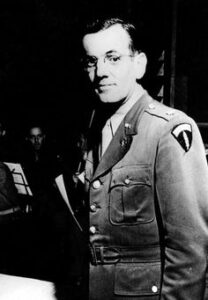 People tend to be drawn to mysteries, especially when it involves the disappearance of a celebrity. Of course, we always hope for a good outcome, but that is not always meant to be. Many people these days don’t know who Glenn Miller is, mostly because of the era he came from. Glenn Miller was an American big band conductor, arranger, composer, trombone player, and recording artist before and during World War II, but during World War II, he was an officer in the US Army Air Forces. It was in his role as a military officer when Glenn Miller went missing on December 15, 1944, after heading out over the English Channel on a small military plane bound for Paris. or apparently so.
People tend to be drawn to mysteries, especially when it involves the disappearance of a celebrity. Of course, we always hope for a good outcome, but that is not always meant to be. Many people these days don’t know who Glenn Miller is, mostly because of the era he came from. Glenn Miller was an American big band conductor, arranger, composer, trombone player, and recording artist before and during World War II, but during World War II, he was an officer in the US Army Air Forces. It was in his role as a military officer when Glenn Miller went missing on December 15, 1944, after heading out over the English Channel on a small military plane bound for Paris. or apparently so.
Shortly after the world learned that Miller, one of the University of Colorado Bould most distinguished alumni, had disappeared, the conspiracy theories began to fly. The fact that Miller was never found, just adds to the mystery surrounding this case. That doesn’t mean that the search is over. Still, 80 years is a long time for a mystery to remain unsolved. It is not for lack of trying, that the disappearance remains a mystery. For Miller’s family, I’m sure all the continuing speculation gets to be annoying, especially when it involves some sensationalistic theories designed to discredit Miller. Theories include things like an assassination before he even boarded the plane he was supposedly on for the purpose of a secret mission for Dwight Eisenhower, or that he made it to Paris ha died of a heart attack in a bordello (I find this one very distasteful, in that it is defamation of character), or that the small plane he was on was destroyed by bombs jettisoned from a phalanx of Allied bombers passing overhead on their way back from an aborted mission over Germany. I’m sure there were others, but without proof, people shouldn’t speculate.
Eventually, long after the war was over, the truth (at least as far as it will ever be proven) came out. Typical of the US government…and many other governments too, I’m sure…documents from the investigation were boxed  up after the war, sent to the United States and locked away. I understand the need to keep wartime documents under wraps, but so many years later…why is it necessary to hide that information from the grieving families. The information was there, they were just not given access. It turns out that witnesses saw Miller get on the plane, and the plane, a C64 Norseman, had a known problem with the carburetor heaters. While the bodies and the plane were not found, it is pretty certain that the freezing weather that day froze the lines, causing the plane to crash shortly after takeoff. I don’t suppose we will know for sure, until the plane is found, but after all these ears, that seems unlikely.
up after the war, sent to the United States and locked away. I understand the need to keep wartime documents under wraps, but so many years later…why is it necessary to hide that information from the grieving families. The information was there, they were just not given access. It turns out that witnesses saw Miller get on the plane, and the plane, a C64 Norseman, had a known problem with the carburetor heaters. While the bodies and the plane were not found, it is pretty certain that the freezing weather that day froze the lines, causing the plane to crash shortly after takeoff. I don’t suppose we will know for sure, until the plane is found, but after all these ears, that seems unlikely.

 My grandniece, Reece Balcerzak is a spunky, happy girl, with a bubbly personality. I love seeing Reece’s interactions with and views of the world around her. She views everything with a sense of wonderment and delight. You might think that because she got a super early start in life, her parents might feel the need to be overly protective, but they are level-headed people who realize that once she left Presbyterian Saint Luke’s Hospital in Denver, Colorado, she was a strong, healthy baby. Reece was a fighter…at least in that sense of the word. Other than that, she is just a happy girl, who doesn’t really do a lot of fighting. Reece is big sister to her little brother Asa, and they sure do love each other. Reece is a born motherly type, and she loves to show her brother everything she knows, especially how to have fun.
My grandniece, Reece Balcerzak is a spunky, happy girl, with a bubbly personality. I love seeing Reece’s interactions with and views of the world around her. She views everything with a sense of wonderment and delight. You might think that because she got a super early start in life, her parents might feel the need to be overly protective, but they are level-headed people who realize that once she left Presbyterian Saint Luke’s Hospital in Denver, Colorado, she was a strong, healthy baby. Reece was a fighter…at least in that sense of the word. Other than that, she is just a happy girl, who doesn’t really do a lot of fighting. Reece is big sister to her little brother Asa, and they sure do love each other. Reece is a born motherly type, and she loves to show her brother everything she knows, especially how to have fun. 
Both Reece is her own girl, and she follows her own path. Her parents, Keifer and Katie Balcerzak, are her biggest fans, and who can blame them. Reece is a sweet little treasure with an infectious giggle. She looks at life with a happy-go-lucky attitude, and she doesn’t let anything get her down. I’m not even sure I have ever seen her with a serious or scowling look on her face, but I suppose there must have been a time or two when she did. The fact is that Reece looks at life as a gift to be treasured and a challenge to be met. Maybe that comes from her uncertain beginnings, but the fact that she was a teeny tiny little preemie girl has never held her back.
Reece is a first grader this year, and she loves going to school, playing with her friends, and learning new things. She has a curious mind, and a playful spirit. I’m sure that like most first graders, her favorite class is 
 recess, but I’m also sure she is a good little student. She makes friends easily, and she is very resourceful. She likes to be active and has tried a number of different sports. I don’t know if she has settled on any one thing as her absolute favorite, but she has lots of time to make up her mind. For now, she has her own ideas on things, and while her ideas may not be what the rest of the world thinks, Reece just doesn’t care. She only needs to be true to herself anyway, right. Today is Reece’s 7th birthday. Happy birthday Reece!! Have a great day!! We love you!!
recess, but I’m also sure she is a good little student. She makes friends easily, and she is very resourceful. She likes to be active and has tried a number of different sports. I don’t know if she has settled on any one thing as her absolute favorite, but she has lots of time to make up her mind. For now, she has her own ideas on things, and while her ideas may not be what the rest of the world thinks, Reece just doesn’t care. She only needs to be true to herself anyway, right. Today is Reece’s 7th birthday. Happy birthday Reece!! Have a great day!! We love you!!

